Rainbow Hydra - 2+ player strategic mode for Magic the Gathering
Last update: 2014/11/28
Note (2015/10/13): I am building another 3 Hydra packages and there is a fairly big update scheduled, mainly on deck building hints plus some optimizations on 'pointy Hydra' better balancing. Pending in backlog.
This page describes characteristics, rules and hints how to play Rainbow Hydra (RH). If you managed to get here by mistake, Magic the Gathering is a card playing game and you can read a lot about it on other places - wikipedia for example
Hydra is meant for players knowing basic MtG (Magic the Gathering) rules. Basically, rules of MtG are not trivial and it takes some time to learn it well. RH is building on a MtG rules and adding some more, together with changing others. If you are inexperinced in playing regular MtG, take your time and learn basic MtG first. Alternatively you can start to play RH with somebody familiar with the system.
Hydra's summary
Before diving into rules and examples, let me briefly describe the biggest differencies between (almost any) MtG gameplay and RH:
- There is only one Deck, shared by all players.
- The Deck is separated into several libraries.
- Every card's color is recognizable very easily as a card is inside of a colored sleeve (red cards in red sleeves, ...)
- Player picks a library to draw from, therefore he is quite sure what is he about to draw (he knows what color and roughly what type (land/nonland) is he to draw).
If you know MtG well, you are seeing a drastical change in gameplay even now, without diving into RH deeply. Basically, the game is much more balanced in terms of players having more equal chances, competing with their skills better than their cards. You will see even more balancing elements during rest of this page, ending up with a few Hydra's extensions making the game balanced quite well while still keeping some (limited) space for lady luck.
Brief illustrated example
Ok. Lets prepare a deck for basic Hydra and show a beginning of a game.
Here it is prepared (sorry for all the pictures inquality):
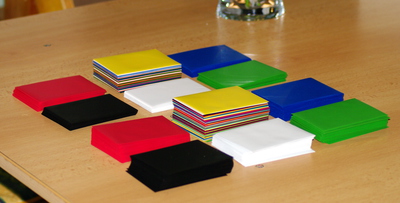
Scared? You can notice there are 2 main libraries - those with mixed card colors. Other libraries are auxiliary libraries, containing cards of the same color. Why there are so many libraries - six would be enough, right? No.
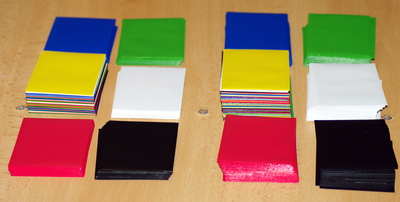
Notice the libraries are split into two groups. Left group are lands, right group are nonlands. What are those yellow cards? Colorless and non-basic lands. These can be only in one of these main libraries. The main library does not have to have a yellow on top, this were arranged for presentation purposes only.
In the following example, we are going to keep things simple. You will see the main points, not a fully blown RH. Lets start the game!
There are three players: Jack, Jim, and Jane.
We are playing Hydra, in particular '2d/0 Hydra 40"' which means we will start with hand containing 2 random lands and nothing more.
After distribution, player's hands on top of picture:
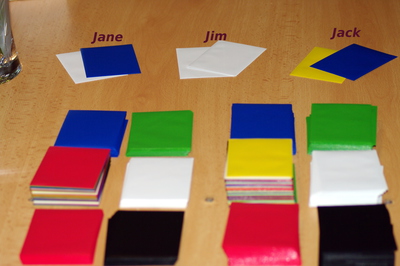
Only lands were distributed. Just by looking at the cards back you can tell Jack received one non-basic land and one island, Jim is pure white and Jane white-blue. Also you can tell that the mixed land library has red land (mountain) on top.
Jack's turn.
Jack's drawing phase. Now, read well: Jack can choose which library is he to draw from. Drawing from any of the two main libraries (mixed colors) does not involve paying any mana costs. We are at the beginning of game, no lands are played, no mana available. Jack is now limited to choose from basic libraries - one being a land library and one being a non-land library.
Jack looks at what is being offered at the libraries. He can draw red land or colorless nonland. Now, read well: Jack remembers playing land rule change: drawing land in drawing phase means you cannot play a land during that turn!
As Jack has no land on the table, he definitely wants to play a land. Therefore, he will draw from nonland main library. Jack draws and here is his hand:

Jack decides to play island. There is nothing more he can do during this turn.
Jim's turn.
Jim has two white lands and looking at the main libraries - there is red land and white nonland. Jim definitely wants to play a land during first turn. He draws a white nonland and here is his hand:
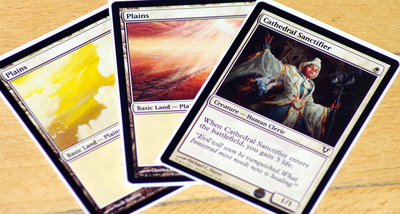
Jim plays an Island and Cathedral Sanctifier.
Jane's turn.
Jane draws a black nonland (Duskmantle Prowler) and plays island.
Back to Jack. Jack has an island on the table. His hand is Evolving wilds (non-basic land which can be sacrificed to get any basic land) and Patagia golem (artifact creature, cost 4). What is offered at the libraries?
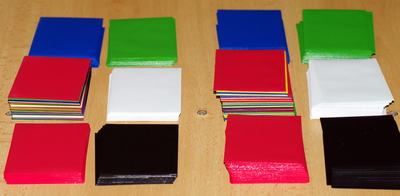
Red land and red nonland. Jack does not like it. Luckily he remembers a 'color call' rule:
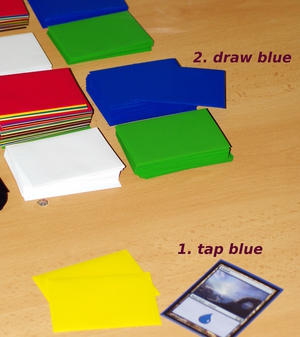
He taps blue draws blue. He does want to play a land in this turn so he draws a blue nonland. Note that the blue mana is consumed, it does not stay in the pool.
Jack gets Fog bank, flying defender, cost 2.
He plays the evolving lands, taps it, sacrifies it and takes another island.
Lets skip Jim's turn and look at Jane's.
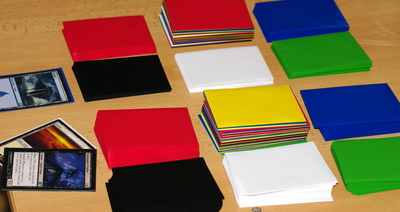
Poor Jane would you say. Jane does not want a red land. She is decided to use that Prowler. How? You will see.
Jane takes a colorless nonland and plays white land.
Jack plays Fog Bank, Jim takes red land and attacks Jane.
Jane's turn again:

Jane want to get a black land. There is no such land on the main land library, neither she has a black land to use color call. But she does have two different colors, so she could do a combined colors call. She taps both blue and white and she is now entitled to draw any color - so she takes black land! Note both mana points are consumed during the combined colors call
As she took a land during draw phase, she cannot play a land this turn. Nevertheless, she will play it next turn.
And that was the introduction. Remember that you can also see the colors of cards on your oponent's hand - so you can speculate what is (s)he about to draw/do. You can also remember what did he draw so you know also the number of lands/nonlands. Last but not the least, game usually starts with a bigger hand than 2d/0 so there are usually much more combinations available from the beginning.
Following are the more complete rules for RH. There are also a few extensions available, I will add them once they are tested enough.
Hydra rules
- Deck is shared between all players
- You can tell card color by just staring at a card back (using colored sleeves)
- There are 2 libraries to draw from, plus up to 10 additional libraries
- Draw phase + playing a land is changed
Apart from the main points above, there are some recommendations which you may decide to ignore though they are highly recommended.
First to the main points though.
Shared deck
All the players are sharing the deck during play - all the libraries are shared, anyone can draw from any library (given he/she matches conditions below).
For good strategic play, it is neccessary that the players know what cards are in the deck. Otherwise the player building the deck (usually the cards owner (meaning the physical cards being his/her property)) gets advantage.
Recommended deck building rules
- Every color taking part in the deck has to have equal number of cards (example: 20 lands for each basic land type, 35 nonland cards for each color)
- If you decide to put in non-basic lands, make them maximally half number of each color (max. 10 in our example)
- If you decide to include colorless and multi-colored nonlands, put no more than 2/5 of nonland-colored (max 14 in our example: 2/5*35)
- Balance colors at least a little bit (putting flying creatures in blue color only and no means to defend them into other colors could degrade gameplay - see more on balancing tips section)
Deck size
- Depends on Hydra subtype. E.g. if you are about to play Continuous Hydra, you could use bigger deck (Continous means you are playing consecutive games with the same players using the deck until there are no cards - more below)
- Depends on number of players. I usually use about 300 cards deck (100 lands) for Continuos play of two players and i can tell it is enough for at least a few games. 300 is enough even for 4 players (just a few Continuous plays). You don't even need to throw in more lands as 100 lands is enough for 4 players.
Sleeves
It is absolutely necessary to use sleeves (or any other way how to identify a card color when looking at card's back). In our example we are using all 5 colors plus colorless plus nonbasic lands. You would need 6 differently colored sleeves in that case.
It is ideal to map sleeve color to card color: put red cards in red sleeves, white cards in white sleeves,... you got the idea. You would need sixth color for other cards - nonbasic lands, artifacts and multi-colored (if using any). You may decide to dress multicolored in seventh color as they are completely opposite of colorless (you will see later on). You may also decide to make colorless/multicolored without sleeve - note you will have problems with shuffling due to different size of cards.
Libraries
Now, the most important stuff.
- Split cards on lands and nonlands.
- Split cards depending on colors (one pile for black, one pile for green etc.).
- If you play all colors, you get 12 (13) piles (green lands, blue lands, white lands, red lands, black lands, non-basic lands, white nonlands, green nonlands, red nonlands, black nonlands, blue nonlands, colorless+multicolored (multicolored can be separate)).
- Shuffle each pile.
- Prepare main libraries:
- Prepare main lands library: take equal number of lands of each color, take all nonbasic lands. Shuffle (for more balanced gameplay see shuffling tips below). For the sake of our example take 8 of each basic, 8 nonbasic (we have 8 non-basic lands in our example).
- Prepare main nonlands library: take equal number of nonlands of each color, take all colorless+multicolored nonlands (example: 8 of each color, 12 colorless artifacts (no multicolor in our example)). Shuffle.
- All other piles remain as separate libraries available for drawing under specific conditions (see below). Arrange libraries so that player is always sure which library contains what - make area for land libraries and area for nonland libraries. In our example we have two main mixed libraries and 10 auxiliary single colored libraries.
Draw phase
Now the most most important stuff - how do you draw?
In your drawing phase, YOU decide from which library to draw.
If you want to draw from any of two main libraries (those with mixed cards color), do it - choose one of the libraries and draw a card.
Alternatively, you may not like the colors being offered on top of the two main libraries. Example: you are in the beginning of the game, you have blue+green nonlands on hand, three forests and one mountain in play. While you are desperate for an island, there is a black land (swamp) on top of the main land library. You do not want a swamp and you do not have a card to search your library for a...'.
Your options (apart from taking the swamp):
- Tap forest and draw from a green library (you choose if green land or green nonland library).
- This rule is called color call. You tap a color (land), you can draw from particulary colored library.
- Tap a forest and mountain and draw from a blue land library. Or any other library.
- This rule is called combined colors call. You tap two different colors (lands), you may choose draw from any library. This is a way how to reach to a not-yet-owned or not-at-the-moment-available color. Remember colorless has no color - you may not use colorless mana for combined colors call.
- Tap three forests and draw from a blue land library. Or any other library.
- This rule is called strong call. You tap three same-colored lands and can choose from any library. This is a way how to enrich your colors when you have a single color only. As this does not require a color combination, you MAY use three colorless here.
- IMPORTANT: all mana gained to fund drawing operations is consumed by these operations. Tapped lands untap as usually (in nearest untap phase, using ability etc.) That said, mana is consumed according to actual mana needed. Meaning: you tapped three forests to fund drawing from red nonland. Before taking the card you actually change your mind and take green land from green auxiliary land library - in this case, one green mana is consumed, other two staying at the pool.
- MORE IMPORTANT: you can do any type of call anytime you would draw.
- Note these drawing rules changes quite a lot when playing strong strategic mode (Promiscuous).
Playing a land
This is very important rule. Without it, you lose a lot of strategic thinking needed to play Hydra:
By drawing a land card during your Draw Phase you lock yourself out of a possibility of playing a land the same turn.
In other words: Either draw a land (during draw phase) or play a land. No possibility to do both in the same turn.
Note that drawing a land outside of a draw phase does not interfere with playing it during the same turn. If you posess a way how to draw before/after Draw Phase, you can happily draw a land and play it the same turn (if you have not drawn a land during your Draw Phase of course). Note to beginners: MtG rules allows playing a single land during turn only. So without any tricks, your maximum land throughput average in RH is half a land per turn.
Additional stuff
- If you need to address your library, it is a combination of the two main libraries.
- It is recommended to not use cards like reveal cards from your library until you find creature/land... when constructing a deck. If you do, here is a reveal algorithm: to reveal a card from your library, throw a dice. 1, 2 - reveal card from main lands library. 3, 4, 5 - reveal card from main nonlands library. 6 - throw again. Repeat the revealing process as long as needed.
- It is recommended to drop a rule if you cannot draw you lose. Instead, keep playing. Players could draw from auxiliary libraries (by doing some type of call) or skip drawing phase otherwise. Game ends when none can draw/play card/attack or players agree on draw (nobody wins).
- It is recommended that the first player does NOT skips his/her drawing phase during first turn.
Starting the game
There are two main ways how to start the game:- Distributing cards
- Picking cards - players are picking their own starting hand
- Choose shuffling player.
- Shuffle if not yet shuffled.
- Oponent removes cards (or is 'takes down' right term in English?) blindly.
- Distribute land cards in round robin fashion - one card to first player, one to second player, ..., second card to first player, ...
- Distribute nonland cards round robin
-- folowing points if distributing cards only --
Note that distributing means distribute from main libraries (random colors).
On the other side, 'picking' means players are taking cards from (usually) single-colored libraries, therefore they cannot pick colorless/multi-colored and nonbasic lands.
Starting hand
- x/y Hydra: Distribute x lands and y nonlands. Favourite: 2/0 Hydra
- Hungry Hydra: empty starting hand
- Weary hydra = 3/4 Hydra
- x/y Picky Hydra: players chooses x land cards and y nonland cards before starting the game. All uses same values of x and y. Player choose in round robin fashion so that a particular color library depletion does not impact too much.
- Einstein's Hydra = Players choosing in round robin until one of: everyone has 7 cards OR somebody calls end of picking. This call must be called after a round of picking completes only. After the call, all but the caller can do one last card choosing.
- Pointy Hydra - the most played and most exciting - see Variants below
Hydra variants
Pointy Hydra
This variant improves starting phase, especially when mixed with Promiscuos variant - may be mixed just for the starting phase.
- Each player get 20 points
- In round-robin fashion, players are picking one card after another.
- Every library has its value:
- Main land: 2 points
- Colored lands: 3 points
- Main non-land: 3 points (if agreed to be allowed for picking)
- Colored non-lands: 4 points
- (Possible addition) for 5 points, you may turn one additional not-shown top card from every library. Show it to every player. Alternatively, you may (instead of each library) look at 5 cards from one specific library. You pick one of the shown cards. Then, you return non-picked cards back in the order you choose - turn them back again. Note that when playing promiscuous, you can actually change order on every library this way.
- While starting hand is not limited, remember you have to have max 7 cards at the end of your first turn
- If a player passes once from choosing, he may not choose in subsequent rounds
- Every player not spending 1 or more points adds 1 life point for the game (non-mandatory rule, should be agreed by players before card picking started). Note you can get max 1 life total.
- NOTE: if everybody are taking mostly lands to be able to play land every turn from the beginning, try to combine with Promiscuous variant, you WILL see difference. Once you try Pointy Promiscuous, you will never want anything else!
- Promiscuous enhancement:
- Before start, turn every non-land so that everyone can see the actual card.
- When player chooses card, subtracts points and takes cards, top card of that particular deck is turned so that subsequent chooser can see all available cards again.
- Note that by remembering who is taking which card you may tell a lot about what is going to happen...
Promiscuous Hydra
For using promiscuous enahancement for initial phase (picking cards), see above
Playing Promiscuous Hydra could be more time taking and it is recommended to try non-promiscuous variant first.
Main point of this variant is that the players are (under meeting some conditions) able to see what cards are on the top of each deck.
There are two variants of play:- Plain promiscuous Hydra
- Top card of each non-land decks are exposed all the time.
- You may actually turn the whole deck so you don't need to turn every card separately.
- This variant is easier to play.
- Tricky promiscuous Hydra
- Initially, top cards are not exposed. If you started Pointy, you may:
- (A) Decide to start exposed.
- (B) Put exposed cards at the bottom of each deck
- You may start exposing cards at the beginning of your Drawing. Remember then when you expose, you always need to pay at least one mana, regardless on which card you finally take:
- If you tap (any, even colorless) mana:
- You man expose (turn) a top card of a deck.
- You may repeat exposing a top card of a deck as long as you wish and there is a non-exposed top card.
- Now you draw:
- Main libraries: mana is consumed - note this is different to the normal RH!
- Non-main library:
- You must obey to the color rule:
- (A) Your chosen card is of the same color as the mana already part of your pool (you used the same color land for entering the exposing mode) - in this case no further payment needed, mana is consumed, draw card.
- (B) You have tapped different color:
- Now you tap another land, different color than original, different color than card color (not colorless!): you used combined colors call, both manas are consumed, draw
- You tap additional two lands of the same color as the first one: you used strong call, all three mana are consumed, draw.
- Now you tap another land, different than original but matching color of the card you want to draw: new mana is consumed, old STAYS IN POOL. Think of it that you rescued your original mana investment.
Funny Hydra - Double pay double fun
Regardless of title, this is serious.
This is very simple rule. You may remember it as Double pay, double fun.
The point is that you can draw two cards instead of one if you pay each of them twice.
Example:- Jane wants to take green non-land and red non-land
- Jane pays:
- Two green manas for green non-land - pays twice.
- One red mana, one black and one blue (She got just one Mountain untapped so she uses combined color call to obtain second red from Swamp and Island) to double pay for the red non-land
- Double PAY. This means you have to take cards which are paid - not from the main libs
- Choosing is instant. You may not do any other operation in the meantime. You may not take two cards from the same library.
- You may choose (have fun) from which library to take from as long as you choose from non-lands.
- YOU SHELL NOT TAKE TWO LANDS this way
Fair Hydra - Triple pain, chance to gain
Though this rule adds a chance when someone has bad luck with cards, it may prolong the game a lot.
This may be extra usefull when used with double pay double fun
Idea here is very simple: when a player suffers three pains during turn of one player, she is entitled to draw (immediately).
There are some limitations though:- Three pains means three separate events - any of:
- Player health damage is dealt. Note it does not depend on number of life taken:
- One lightning bolt - one event. One creature deal damage - one event.
- Note player may self-inflict a pain by an instant (it is precalculated but it still hurts as you cut to your own flesh)
- Player's creature is lost.
- Either life=0 or any other effect. It is removed to grave or exile or stolen to other player's hand/battlefield. Other destinations do not count.
- Sacrifice does not count (it is a pre-calculated loss, not a real pain), neither when creature is regenerated, two creatures control exchanged (no pure loss) etc.
- Creature color is creature's blood, so the player can use this to recolor mana potentially spent on colors call.
- Some examples:
- Jane lost a Tarpan and also suffered Health damage. Two pains - doesn't count.
- Jim lost three creatures during Jane's turn. He is allowed to shout triple pain immediately when pain is suffered (no later):
- Two creatures were black, one black-red. Blood is black and red.
- Jim has four blue and two green lands untapped
- Jim decides to combine this rule with double pay double fun. He needs to pay for each card twice!
- Jim taps all untapped lands.
- Jim recolors two blue mana in black blood, so he does have two black, two blue and two green
- Jim takes one black card (paid twice by black mana)
- Jim wants to take that white Angel as well (playing promiscuous Hydra, card is exposed from previous turns) so he does two combined colors call to obtain two white mana from two blue and two green ones. Good to go now.
- Just to have the example complete, Jim is playing Funny Fair Tricky-Promiscuous Pointy Hydra
Rainbow Hydra - the final extension
This is the final extension to the Hydra. This extension was meant from the beginning but I had to balance Hydra rules a little bit prior to introducing this extension.
Please note that this bunch of rules would probably change.
General idea behind Rainbow Hydra is that it should encourage multi-color play. The Rainbow extension is for exactly this.
Rainbow extension has three groups with three different usages, depending on how strong Rainbow you decide to create.
Rainbow is not a spell. Its effect goes on the stack directly, so there is no way how to counter it.
Rainbow groups and usages:
- Rainbow Bridge
- lev.1: Bridge to a deck - you can draw top card from any library (no other costs).
- lev.2: Bridge to a grave - you can draw top card from any graveyard.
- lev.3: Bridge to an enemy - one of your creatures can attack over a rainbow bridge (not blockable attack).
- Rainbow Shield
- lev.1: Prevention - prevent up to 5 damage from any source to a target. Target is a creature or artifact on your battlefield or yourself.
- lev.2: Protection - protect a target (on your battlefield/yourself) from a color for this turn.
- lev.3: Invulnerability - protect a target (on your battlefield/yourself) from any efffect causing damage or any effect provided by a card/spell/anything for this turn. E.g. the target cannot be removed from battlefield/destroyed/damaged.
- Rainbow Effect
- lev.1: Healing effect - heal up to 5 points to a target on your battlefield or yourself. Target has to have at least 1 point of health before healing effect could be used.
- lev.2: Interference effect - immediately cancel either a spell or an effect on the top of stack. This is the only way how to cancel another Rainbow. Note the interference effect does not go on the stack, it immediately cancels top of the stack. Therefore, interference effect cannot be interrupted by another interference effect.
- lev.3: The Visions effect - pick a player or a deck. You may look at at most 15 cards of this target (deck - 15 from the top; player - 15 from left or right (you choose)). You may rearrange the cards in different order in case of a Deck visions.
Rules for Rainbows:
- Each player may call for a Rainbow once per turn.
- Costs of Rainbow calls:
- level1: 5 mana of different color each
- level2: 2 mana of each color
- level3: 3 mana of each color